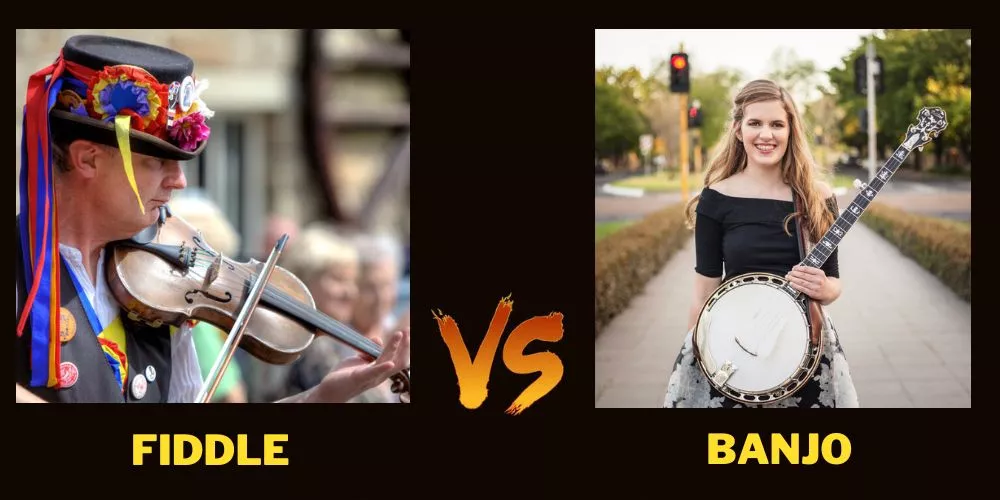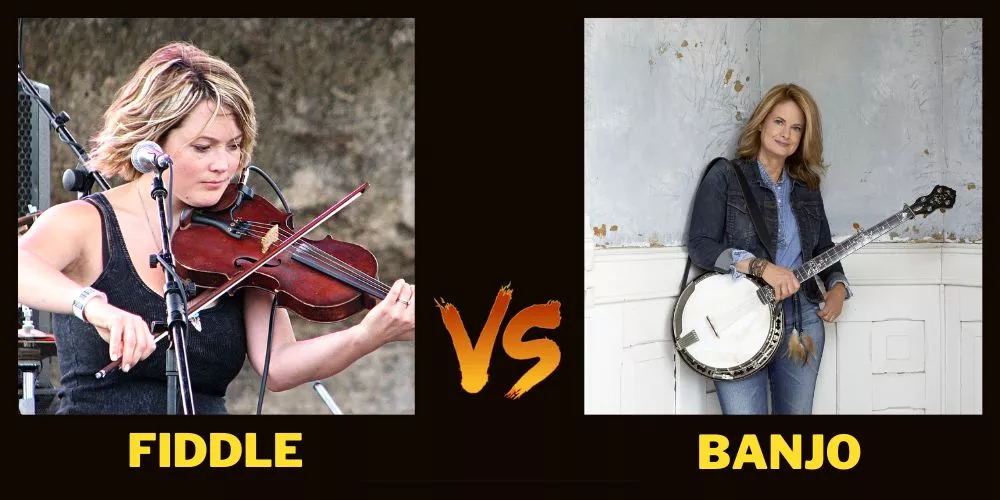Music is a universal language embodied in diverse instruments, each with its unique sound and charm. This article focuses on two such iconic instruments – the fiddle and the banjo, both rich in history and cultural significance.

Despite their similarities, especially in being major players in traditional folk, bluegrass, and country music, there’s a key difference to keep in mind; while the banjo is a stringed instrument played percussively, lending its bright, rhythmic notes, the fiddle, a type of violin, offers a more mellow, melodically nuanced tone, making each one distinct in its musical function and appeal.
Contents
🎶Fiddle vs Banjo: A Detailed Comparison
The diversity present in the world of music is as fascinating as it is wide-ranging. Among the numerous instruments that exist, the fiddle and the banjo impress with their unique soundscapes, making significant contributions to various music genres.
This in-depth comparison aims to highlight the characteristics, use, origin, and significant differences between these two beloved instruments.

Origin & Cultural Significance
The fiddle is essentially a violin, used in specific music genres where it is played differently than a traditional violin. It’s embedded in the musical landscapes of Europe since the 10th century. The fiddle’s association with folk and traditional music makes it a symbol of cultural heritage across global societies, particularly in Ireland, Scotland, and the Appalachian region in the United States.
The banjo finds its origins in Africa and came to America through the slave trade. With roots connected to the ‘Akounting’ instrument, the banjo has become a defining symbol of American bluegrass and folk traditions, knit deeply into the social fabric of the country.
Design & Construction
The fiddle is a stringed instrument crafted from wood, typically consisting of spruce or maple. It has four strings, a tailpiece, a bridge, and is played using a bow made from horsehair. The fiddle’s body shape and size help produce a wide tonal range and dynamic sound, which can be soft or energetic, depending on the player’s intent.
The banjo, on the other hand, follows a distinct construction, with a drum-like body called the “pot” usually covered with a vellum strip that gives it its unique twangy tone. Most banjos have four or five metal strings which, unlike the fiddle, are plucked or strummed using a pick or fingers.
Sound & Role in Music
Although both the fiddle and the banjo sit comfortably in the traditional folk, bluegrass, and country genres, the difference in their sounds and musical playability makes the two distinct. The fiddle can provide long, sustained notes, offering the ability to play complex melodies with a considerable emotional range. Its sound is warmer, smoother, and can be delicately modulated.
Conversely, the banjo, with its bright and vibrant twang, offers an instant rhythmic punch. Its percussive and short attacks make it ideal for creating fast-paced riffs. Banjos often play a relentless repetitive pattern, termed “rolls,” establishing a groove and bouncing rhythm beneath the music’s surface.
Learning Curve & Playability
Given their unique features, both the fiddle and the banjo come with their respective learning curves. For a fiddle, intonation is a significant challenge since it doesn’t have frets. Players must place their fingers at precisely the right spot to make the correct pitch, demanding meticulous practice over the years.
Learning the banjo, despite its mechanical simplicity, requires a mastery of complex right-hand fingerpicking patterns. Though finding the correct pitch is easier with its fretted neck, achieving the speedy finger rolls can be an equal, if not more significant, hurdle for beginners.
Which is better?
In comparing the fiddle vs. the banjo, the pivotal difference lies in their application within music. While the banjo delivers a driving rhythm with its percussive play and bright sound, the fiddle offers melodic depth and warmth with its capacity for sustained notes.
Both carry historical and cultural weight, often serving as celebrated markers of identity in their respective traditions. The choice between a banjo and a fiddle often boils down to personal musical preferences and the spirit of the sound each player aims to create.
🎶Is the banjo or fiddle easier to play?
When assessing which instrument is easier to play – the banjo or the fiddle, one must consider several elements such as physical demands, learning techniques, and intuitiveness of the instrument. While both instruments have their unique challenges, it’s essential to underline that ease of learning often depends on an individual’s aptitude, musical background, and dedication.
The banjo has frets, much like a guitar, which guide the fingers to the correct positions, making the initial learning stage seemingly more straightforward. On this instrument, mastering the rhythmic patterns and “rolls” typically present the most substantial challenge, especially for those with less rhythmic instinct.
Contrarily, the fiddle requires more precise finger placement given that it doesn’t have frets. The production of a pleasant, in-tune sound on a fiddle may be physically harder for beginners due to the necessity of simultaneously managing the bow’s pressure, speed, and placement while ensuring correct left-hand finger positioning.
However, music reading for a fiddle could be regarded as less complex than the banjo because it generally plays one note at a time while the banjo often involves playing several simultaneously.
In conclusion, neither instrument naturally presents as being ‘easier’ to play than the other; instead, it deviates depending on the player’s personal strengths and what aspects of music come more naturally to them.
The banjo might seem more accessible to those already familiar with fretted instruments like the guitar, while the fiddle could appeal to those with an aptitude for melodic intuition and an interest in refining the nuances that come with bowing techniques. The key to mastering either instrument lies in consistent practice and inherent passion for the music it creates.
🎶Banjo or Fiddle? Beginner Level Differences Explained
When it comes to choosing between the fiddle and the banjo for beginners, it really depends on your personal preferences and musical goals.
The banjo is a member of the plucked string instruments family. It has a deeper hardwood body and a more complex design than the fiddle. Typically, the banjo design is larger than the fiddle’s, with deeper wooden bodies. This instrument is fretted, like a guitar, and often involves playing several strings at the same time which can provide a clear guide for beginners but also can be challenging.
On the other hand, the fiddle, predominantly used in classical and folk music, requires a different set of skills. It often involves the presence of a bow. Coming from the violin family, the fiddle generally produces more calm and gentle sounds than banjos. Notably, the absence of frets on the fiddle implies that a learner has to be precise with finger placements to produce a correct tune, which can be slightly difficult at first.
Both instruments have their learning curves and advantages. If you are interested in rhythm and like the twangy sound, perhaps the banjo is for you. If you are drawn to the melody and want a softer and more elegant sound, the fiddle might be your instrument of choice.
Ultimately, whether you choose the fiddle or the banjo, the most important thing is to enjoy the process of learning and making music!
Other comparison you may like to read: Ukulele vs Banjo | Mandolin vs Banjo
Conclusion:
The contest between the fiddle vs banjo isn’t about which is superior but rather which best suits an individual’s musical preferences and aspirations. Each instrument, with their unique sound, design, and cultural significance, holds its unique appeal.
The fiddle charms with its melodious tunes and emotional breadth, whereas the banjo captivates with its rhythmic punch and iconic twang. The decision hinges on your sonic leanings, the pull of the genres associated with these instruments, and the challenge of their distinct learning curves. Regardless of your choice, both instruments offer rewarding journeys into the realms of music-making.
